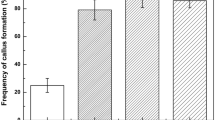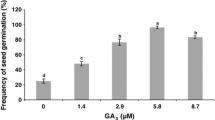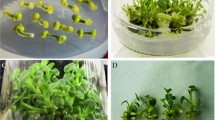Summary
Callus induction and later plant regeneration were studied in four widely grown garlic (Allium sativum L.) cultivars from Europe. Root segments from in vitro plantlets were used as starting material. In addition to cultivar effects, the effects of auxin and cytokinin levels and the position of the segments on the root were studied. There were no statistically significant differences among cultivars for the number of root segments that induced callus in the two series of experiments. The average induction frequency was 34.7% in the first series of experiments. Callus induction on apical root segments was significantly higher compared to callus induction on non-apical root segments in the second series of experiments. Two months after callus induction, callus lines were transferred to a regeneration medium consisting of Murashige and Skoog basal medium supplemented with 30gl−1 sucrose and 1 mgl−1 (4.6μM) kinetin. Calluses derived from different experiments were quite uniform with respect to their regeneration potential. Also it was found that our regeneration system was cultivar-independent. The average shoot regeneration frequency was 17.9% in the first series of experiments. Highly significant differences were found in the frequency of shoot regeneration among different callus induction treatments. When the cytokinin 6-(γ,γ-dimethylallylamino)purine (0.1mgl−1∶0.5 μM) was present during callus induction, shoot regeneration ranged from 30.10 to 47.60%. Shoot regeneration from callus induced on non-apical segments was higher, although not significant, compared to callus induction from apical root segments in the second series of experiments. All in all, an efficient callus induction and plant regeneration system was developed from both apical and non-apical segments taken along the entire length of the roots. This system has potential to be used for garlic transformation.
Similar content being viewed by others
References
Abo El-Nil, M. M. Organogenesis and embryogenesis in callus cultures of garlic (Allium sativum L.). Plant Sci. Lett. 9:259–264;1977.
Al-Zahim, M. A.; Ford Lloyd, B. V.; Newbury, H. J. Betection of somaclonal variation in garlic (Allium sativum L.) using RAPD and cytological analysis. Plant Cell Rep. 18:473–477; 1999.
Ayabe, M.; Sumi, S. Establishment of a novel tissue culture method, stemdisc culture, and its practical application to micropropagation of garlic (Allium sativum L.). Plant Cell Rep. 17:773–779; 1998.
Ayabe, M.; Taniguchi, K.; Sumi, S. I. Regeneration of whole plants from protoplasts isolated from tissue-cultured shoot primordial of garlic (Allium sativum L.). Plant Cell Rep. 15:17–21; 1995.
Barandiaran, X.; Martin, N.; Rodriguez Conde, M. F.; Di Pietro, A.; Martin, J. Genetic variability in callus formation and regeneration of garlic (Allium satirum L.). Plant Cell Rep. 18:434–437; 1999a
Barandiaran, X.; Martin, N.; Rodriguez Conde, M. F.; Di Pietro, A.; Martin, J. An efficient method for callus culture and shoot regeneration of garlic (Allium sativum L.). HortScience 34:348–349; 1999b.
Choi, S. Y.; Paek, K. Y.; Jo, J. T. Plantlet production through callus culture in Allium sativum L.. J. Korean Soc. Hort. Sci. 34:16–28; 1993.
Eady, C. C.; Butler, R. C.; So, Y. Somatic embryogenesis and plant regeneration from immature embryo cultures of onion (Allium cepa L.). Plant Cell Rep. 18:111–116; 1998.
Haque, M. S.; Wada, T.; Hattori, K. High frequency shoot regeneration and plantlet formation from root tip of garlic. Plant Cell Tiss. Organ Cult. 50:83–89; 1997.
Haque, M. S.; Wada, T.; Hattori, K. Efficient plant regeneration in garlic through somatic embryogenesis from root tip explants. Plant Prod. Sci. 1:216–222; 1998.
Haque, M. S.; Wada, T.; Hattori, K. Anatomical changes during in vitro direct formation of shoot bud from root tips in garlic (Allium sativum L.). Plant Prod. Sci. 2:146–153; 1999.
Hasegawa, H.; Sato, M.; Suzuki, M. Efficient plant regeneration from protoplasts isolated from long-term, shoot primordia-derived calluses of garlic (Allium sativum). J. Plant Physiol. 159:449–452; 2002.
Kamenetsky, R.; Rabinowitch, H. D. Floral development in bolting garlic. Sex. Plant Reprod. 13:235–241; 2001.
Kehr, A. E.; Schaeffer, G. W. Tissue culture and differentiation of garlic. HortScience 11:422–423; 1976.
Kondo, T.; Hasegawa, H.; Suzuki, M. Transformation and regeneration of garlic (Allium sativum L.) by Agrobacterium-mediated gene transfer. Plant Cell Rep. 19:989–993; 2000.
McCullagh, P.; Nelder, J. A. Generalized linear models. London and New York; Chapman and Hall; 1990.
Murashige, T.; Skoog, F. A revised medium for rapid growth and bioassays with tobacco tissue cultures. Physiol. Plant. 15:473–497; 1962.
Myers, J. M.; Simon, P. W. Continuous callus production and regeneration of garlic (Allium sativum L.) using root segments from shoot tip-derived plantlets. Plant Cell Rep. 17:726–730; 1998.
Myers, J. M.; Simon, P. W. Regeneration of garlic callus as affected by clonal variation, plant growth regulator and culture conditions over time. Plant Cell Rep. 19:32–36; 1999.
Nagasawa, A.; Finer, J. J. Development of morphogenic suspension cultures of garlic (Allium sativum L.). Plant Cell Tiss. Organ Cult. 15:183–187; 1988.
Phillips, G. C.; Hubstenberger, F. Plant regeneration in vitro of selected Allium species and interspecific hybrids. HortScience 22:124–125; 1987.
Phillips, G. C.; Luteyn, K. J. Effects of picloram and other auxins on onion tissue cultures. J. Am. Soc. Hort. Sci. 108:948–953; 1983.
Robledo, P. A.; Villalobos Arambula, V. M.; Jofre Garfias, A. E. Efficient plant regeneration of garlic (Allium sativum L.) by root-tip culture. In Vitro Cell. Dev. Biol. Plant 36:416–419; 2000.
Suh, S.; Park, H. G. Somatic embryogenesis and plant regeneration from flower organ culture of garlic (Allium sativum L.). Korean J. Plant Tiss. Cult. 15:121–132; 1988.
Suh, S. K.; Park, H. G. Plant regeneration from the culture of garlic root explants. J. Korean Soc. Hort. Sci. 36:31–37; 1995.
Wang, H. L.; Kang, Y. Q.; Zhang, C. J. Embryogenesis via culture of garlic spront leaf. Acta Agric. Boreali Sin. 9:92–94; 1994.
Xue, H. M.; Araki, H.; Shi, L.; Yakuwa, T., Somatic embryogenesis and plant regeneration in basal plate and receptacle derived-callus cultures of garlic (Allium sativum L.). J. Jap. Soc. Hort. Sci. 60:627–634; 1991.
Zheng, H. R.; Shen, M. J.; Zhong, W. J.; Zhang, Z. Q.; Zhou, Y. Induction and utilization of globular bodies on calli from garlic (Allium sativum L.) leaf explants. Study of cellular histology in morphogenesis. Acta Agric. Shanghai 14:33–38; 1998a.
Zheng, S. J.; Henken, B.; Sofiari, E.; Jacobsen, E.; Krens, F. A.; Kik, C. Factors influencing induction, propagation and regeneration of mature zygotic embryo-derived callus from Allium cepa L. Plant Cell Tiss. Organ Cult. 53:99–105; 1998b.
Zheng, S. J.; Khrustaleva, L. I.; Henken, B.; Sofiari, E.; Jacobsen, E.: Kik, C.; Krens, F. A. Agrobacterium tumefaciens-mediated transformation of Allium cepa L.: the production of transgenic onions and shallots. Mol. Breed. 7:101–115; 2001.
Author information
Authors and Affiliations
Corresponding author
Rights and permissions
About this article
Cite this article
Zheng, SJ., Henken, B., Krens, F.A. et al. The development of an efficient cultivar-independent plant regeneration system from callus derived from both apical and non-apical root segments of garlic (Allium sativum L.). In Vitro Cell.Dev.Biol.-Plant 39, 288–292 (2003). https://doi.org/10.1079/IVP2002378
Received:
Accepted:
Issue Date:
DOI: https://doi.org/10.1079/IVP2002378




